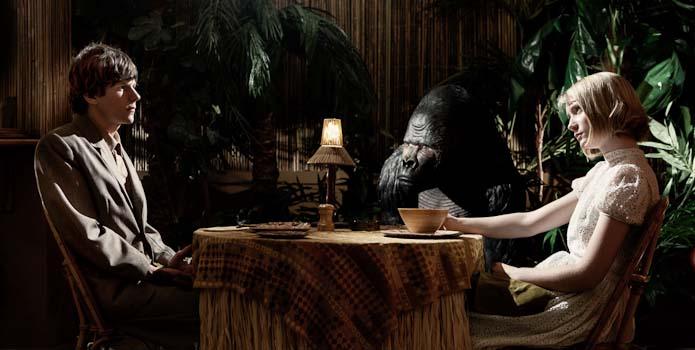Director: Richard Ayoade
Writers: Richard Ayoade, Avi Korine
Starring: Jesse Eisenberg, Mia Wasikowska, Wallace Shawn, Noah Taylor
Runtime: 93 min
Rating: 14A
There are always challenges involved in the translation of literature into film, or indeed, any medium into another. Directed by Richard Ayoade, The Double reimagines the world created by Russian writer Fyodor Dostoevsky in his 1846 novella of the same name. The film endeavours to update the story while retaining the tone and symbolism found in the original. This attempt, however, results in a highly convoluted film in which there is so much going on that it often becomes difficult to understand just what we are seeing and ascertain exactly what we are meant to be feeling.
Jesse Eisenberg stars as the young and introverted James Simon who goes to work one morning only to discover that he has been replaced by his doppelganger. Although Simon James (also played by Eisenberg) looks exactly like James Simon, he boasts all of the characteristics – positive and negative – that James Simon does not. Although James Simon is hardworking and thoughtful, he is unable to communicate with his co-worker Hannah (Mia Wasikowska), on whom he appears fixated. Simon James, on the other hand, exudes confidence and quickly takes over many aspects of James Simon’s life, including his job and his relationships. What follows is a harrowing descent into madness as James Simon attempts to become his own person and to free himself from the control of his ruthless doppelganger.

Eisenberg takes on the challenge of playing two very different, yet physically identical, roles with complete capability. He switches effortlessly from one character into the other, so that although the two may appear the same, even switching clothing for a time, there is never any doubt as to who is who. Wasikowska also shines in her role as the ethereal Hannah, and she is often shot in a dreamy manner, lending brief moments of respite to what is otherwise an intense and rather relentless film. Ayoade makes use of dim lighting, canted camera angles, and unsettling music and sound to reflect his dark tone. Many of these elements are magnified to the extreme, and nearly every scene, even those focused on James Simon at work or visiting his ailing mother in the hospital, is surrounded by an aura of foreboding. Although the dialogue that does appear is sharp and quick, this film employs very little spoken word, choosing to convey much of its meaning through sound instead. Finally, the film does not take place in a discernable time or place; instead, it mixes elements of the time in which the novella was written, such as costuming, with a modern, or even futuristic, style.

While many of these techniques are effective in the creation of an unsettling mood, not all of the symbolism that the film tries to depict works in this medium. Although Dostoevsky’s novella may be short, it is an extremely dense work. In literature, an author may present layer after layer of meaning within his writing, since a reader may take his or her time working through the material in order to digest all with which they are presented. In a relatively short film such as The Double, however, a spectator may feel overwhelmed when presented with this much information all at once. The film attempts to convey so much through the employment of so many techniques that it becomes nearly impossible to sort it all out. The reliance on sound as opposed to dialogue adds another level of convolution. Although this confusion may accurately reflect the mental state of the protagonist, the fact remains that the effect of the movie is diminished when one cannot follow the symbols that it presents.
The Double relates the story of a figurative non-entity who becomes a literal non-entity; ultimately, protagonist James Simon develops into the unnoticeable personified. It is a real treat to watch young actors performing at the height of their talent, and Jesse Eisenberg and Mia Wasikowska deliver smart and nuanced performances that do not fail to disappoint. The flaw within this film, however, is in its attempt to perfectly replicate the original novel. Not all literature translates effectively into film, and unfortunately, a confused audience may end up wishing they had read the book instead.
Photo Credits: Toronto International Film Festival







